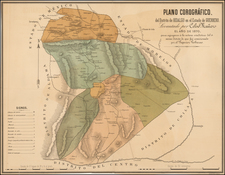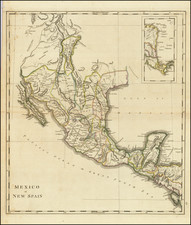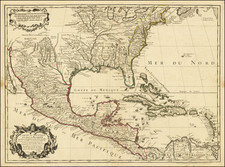Nova Hispania et Nova Galicia by Willem Janszoon Blaeu, published in Amsterdam around 1636, is a stunning cartographic depiction of Mexico during that time. This gorgeous map extends from just north of Mazatlan to Acapulco and from Tehuacan to the Sierra Madres, encompassing Mexico City, Puebla (Angelorum Civitas), Colima, Campostella, Purificatio, and Mechoacan as prominent cities of the era.
Noteworthy for its ornate decorative elements, Blaeu's map features a fabulous armorial title cartouche, sailing ships, a compass rose, and a smaller cartouche. These decorative elements add aesthetic appeal and enhance the visual presentation of the map.
Nova Hispania et Nova Galicia holds significant importance for collectors of Mexican maps. Its detail, ornamental features, and historical accuracy make it an essential addition to any map collection focused on Mexico. The map offers a glimpse into the geography, cities, and regions of Mexico during the 17th century, providing valuable insights into the historical context and development of the area.
The presence of the Notarum Explnatio section on the map indicates the inclusion of notable places, such as Escalpucoleo, Gucytitlan, Circa Mexico, Xiquicpico, Veicilapa, Ocellotepec, Mimiapa, Circa Puri, Caltoca, Chiconantla, Thecheistlan, Tapaleapan, Itapalapa, Mexicalcingo, Catlavaca, Nichquique, Chalcontengo, Circa Colimam, Coquimatlan, Tecoftitlan, Tampuchi, and Aguacapan. These labels contribute to a more comprehensive understanding of the specific locations and regions depicted on the map.
In summary, the Nova Hispania et Nova Galicia map by Willem Janszoon Blaeu is a remarkable cartographic achievement, showcasing Mexico during the 17th century. Its exceptional beauty, detailed cartography, and decorative elements make it a coveted item for collectors and a valuable resource for researchers interested in Mexican history and geography.
Willem Janszoon Blaeu (1571-1638) was a prominent Dutch geographer and publisher. Born the son of a herring merchant, Blaeu chose not fish but mathematics and astronomy for his focus. He studied with the famous Danish astronomer Tycho Brahe, with whom he honed his instrument and globe making skills. Blaeu set up shop in Amsterdam, where he sold instruments and globes, published maps, and edited the works of intellectuals like Descartes and Hugo Grotius. In 1635, he released his atlas, Theatrum Orbis Terrarum, sive, Atlas novus.
Willem died in 1638. He had two sons, Cornelis (1610-1648) and Joan (1596-1673). Joan trained as a lawyer, but joined his father’s business rather than practice. After his father’s death, the brothers took over their father’s shop and Joan took on his work as hydrographer to the Dutch East India Company. Later in life, Joan would modify and greatly expand his father’s Atlas novus, eventually releasing his masterpiece, the Atlas maior, between 1662 and 1672.









![(Texas - Apache Depredations in Mexico) Discurso Que Pronunció el señor Coronel D. José Joaquin Calvo, Comandante general del Estado de Chihuahua, al entrar en ejercicio del Supremo Poder Ejecutivo del mismo [caption title]](https://storage.googleapis.com/raremaps/img/small/93111.jpg)


![Mapa et tierra q[u]e yos pedro Vial taigo transitau en St. Tafee este dia 18 de Octubre de La ao 1787](https://storage.googleapis.com/raremaps/img/small/3645.jpg)

![Mexican Painting. 3776 Codex Vaticanus page 74. Aglio 3rd Vol. called the Little Vatican MS. [on sheet with] Quetzalcoatl Crucified Codex Borgianus...](https://storage.googleapis.com/raremaps/img/small/102318.jpg)